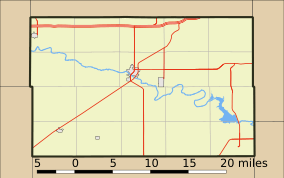Mushroom Rock State Park facts for kids
Quick facts for kids Mushroom Rock |
|
|---|---|

Pedestal formed by nonuniform weathering
|
|
| Location | Carneiro and Ellsworth, Kansas, Ellsworth County, Kansas, Smoky Hills, Kansas, United States |
| Area | 5 acres |
| Elevation | 488 m (1,601 ft) |
| Established | 25 April 1965 |
| Visitors | 290,436 (in 2022) |
| Operator | Kansas Department of Wildlife, Parks and Tourism |
| Website | KDWP Website |
Mushroom Rock State Park is a truly special place in Kansas, famous for its incredible rock formations that look just like giant mushrooms! Located in the Smoky Hills region of north-central Kansas, this park is a fantastic spot to explore nature's artwork. It's found in Ellsworth County, Kansas, in the United States.
Contents
Discover Mushroom Rock State Park
These unique rocks are ancient leftovers from a time long, long ago, called the Cretaceous Period. This was about 144 to 66 million years ago, when dinosaurs roamed the Earth! Back then, this area was covered by a vast sea. Over millions of years, beach sands and other sediments settled at the bottom. These materials slowly turned into sandstone and other sedimentary rock. A natural "glue" made of calcium carbonate (the same stuff in seashells!) helped cement these rocks together. Some parts of the rock were harder than others. Over time, wind and water wore away the softer parts, leaving behind the amazing mushroom shapes we see today. The largest of these rocks is about 27 feet (8.2 meters) wide!
Explore the Park's Unique Features
Even though it's Kansas's smallest state park, covering just 5 acres (2 hectares), Mushroom Rock is packed with wonders. It's even called "one of the eight wonders of Kansas geography"! You'll find two main mushroom-shaped rocks and another cool formation that looks like a giant shoe. There are many other interesting rock shapes to discover too. This small but mighty park is managed by Kanopolis State Park, working with the Kansas Department of Wildlife, Parks and Tourism to keep it beautiful for everyone.
A Place of History and Natural Beauty
Long before it became a state park, these distinctive rocks served as an important meeting place. Both early pioneers traveling through the area and Native Americans used this memorable landmark to gather. Imagine the stories these ancient rocks could tell! On April 25, 1965, Mushroom Rock officially became a state park, protecting these natural treasures for future generations. In 2022, nearly 300,000 people visited this amazing site, showing just how popular and important it is.
Gallery
See also
Other rock formations in Kansas:



